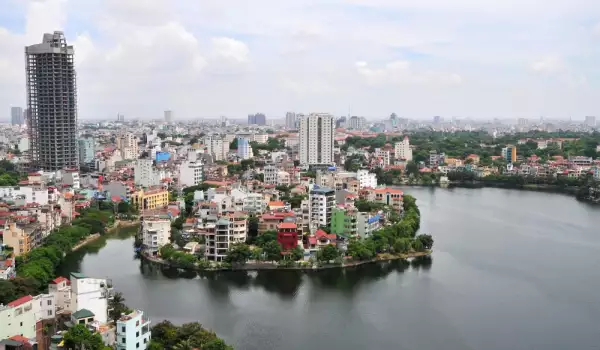Hanoi

The capital Hanoi is Vietnam's exotic megalopolis in which are delicately combined the spirit of modernity and medieval architecture of European and Asian religious inspiration. The city has a rich history. Today, along with picturesque religious shrines and modern buildings, the Vietnamese capital is impressive with plenty of quiet parks and mirror lakes.
In 2010, Hanoi proudly celebrated its 1000th anniversary. Then the Vietnamese capital was officially declared one of the world's top destinations for 2010
Visitors can see remains of buildings dating from the 11th century, scattered between the buildings built by French colonialists.
Hanoi is located on the right bank of Red River. In the capital there are several picturesque lakes. In the historical center of Hanoi is located Sword Lake.
Legends say that it was the waters of this lake that Liu Tai, ruler in the 13th century, gets a magical sword, by which he won an important battle against the Chinese Ming Dynasty. In memory of this miracle in the middle of the lake is a small island, on which was erected a magnificent monument, which is among the main attractions of the city.
Around the lake lies the old part of town. There is felt most strongly the spirit of the ancient Asian village. On the streets there are numerous craft studios, which produce unique items, representing Vietnamese history and culture. In the old part of town, you can find many retailers and restaurants, which serve traditional dishes.

"Old Hanoi" tourists can visit the "Temple of Literature", and the remains of the ancient university of Vietnam, from 1070.
Among the historical landmarks of the Asian city is the One Pillar Pagoda. The Buddhist temple is considered one of the two most important religious temples, along with the Perfume Pagoda, located in Hanoi. This unique temple is built on the foundations of a single stone pillar with a diameter of 1.25 m. The idea was the pagoda to resemble a lotus flower.
The tourist attraction which is colored in red is the Tran Quoc pagoda. This Buddhist Temple is located on another picturesque Lake - West Lake. The unique building dates from the sixth century.
Interestingly, in old Hanoi every Friday, Saturday and Sunday there is a "Night Market". At that time intensive trade of clothing, souvenirs and meals is done.
Hanoi citadel is another landmark in the Vietnamese capital. The Fort was built by the Lee Dynasty in 1010. The old complex was subsequently used as residence of Vietnamese monarchs, as well as the office of the judiciary (1810). On its territory is located the flag tower. It is considered a symbol of the city and the citadel. The building is one of the few remaining undestroyed by French colonists.
Frenchmen mark not only the history but also architecture and contemporary aspect of the Asian city. Among the buildings, symbols of the colonizers are the beautiful Opera House, National Bank, the Presidential Palace and Cathedral of Saint Joseph.
In Hanoi, there are over 600 religious temples and pagodas - more than any city in Vietnam.
Hanoi is still considered the most important educational center in Vietnam. 62% of men of science in Asian countries are living and working in Hanoi. In the capital, as it can be assumed, there are many universities and many other scientific centers.
The best time to visit Hanoi is between September and December. Then the level of humidity is lowest. Overall climate of the North Vietnamese city is hot and humid.
Hanoi is the second largest city in Vietnam. The Capital of the Asian country has a population of over 6.5 million people.








